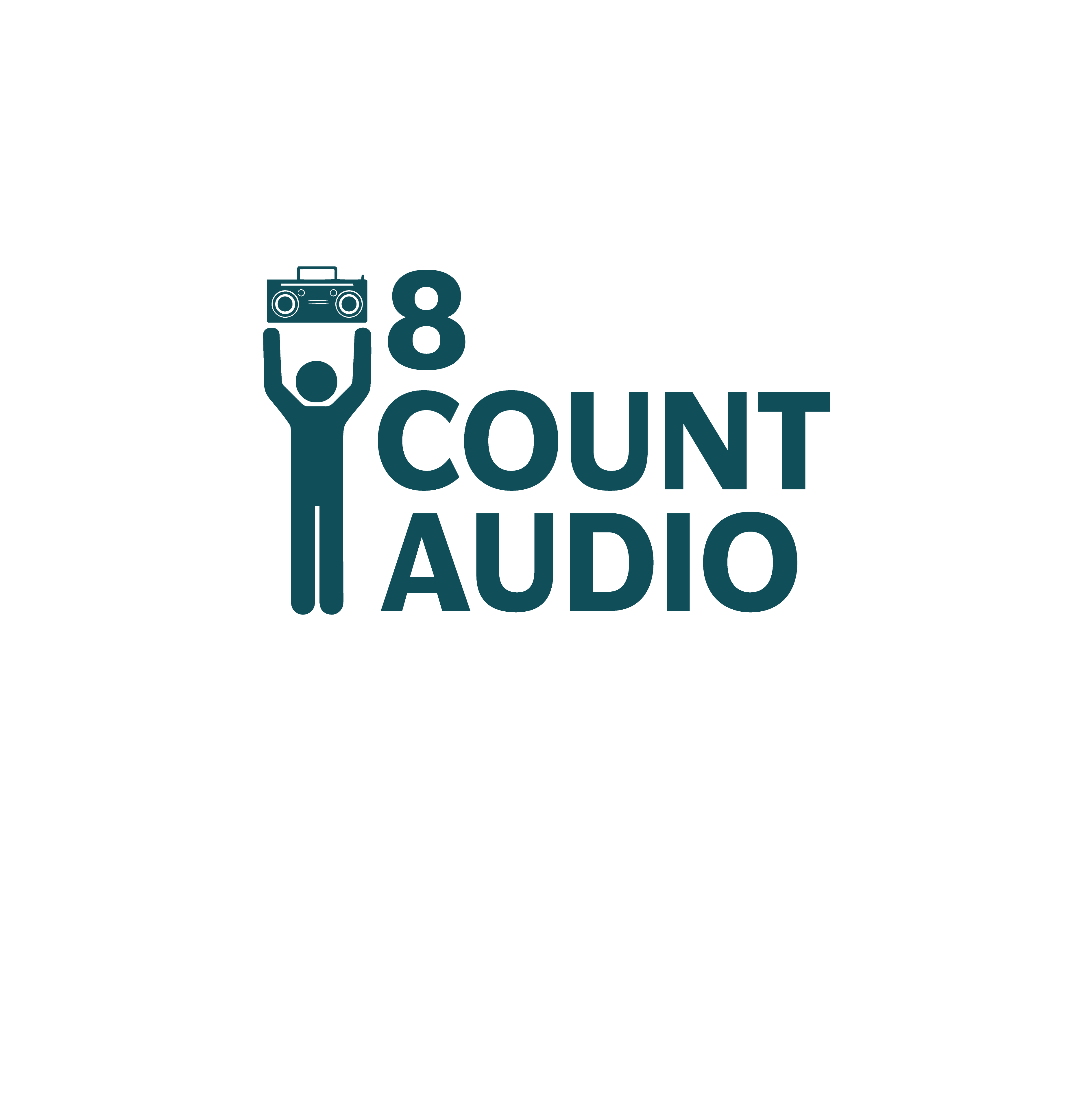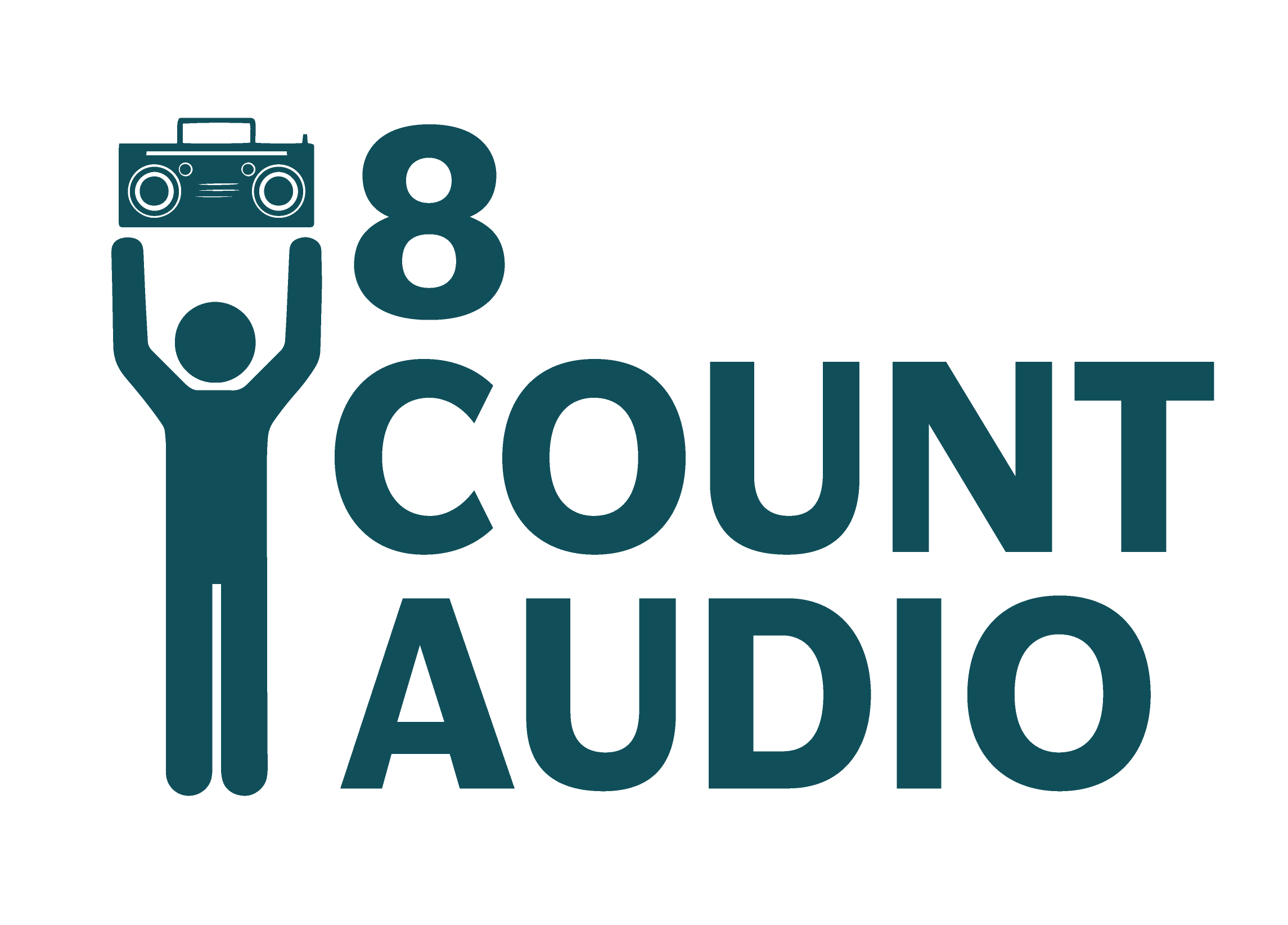What I Look At When Watching Routines
by Norm Ramil / 8 Count Audio team.leader & music.person
Hopefully you’re enjoying a relaxing winter break. In just ten days some of you will be back on the competition floor, which seems like the farthest thing from this moment of crumpled wrapping paper scattered around your living room and your Fitbit begging you to do something.
I thought I’d give you all a glimpse of how I watch routines. This ain’t no rubric! But as a fan who’s watched thousands of routines in IHSA, IDTA, TDI, Halftime Illinois, and UDA, I’ve picked up on the general areas that everyone seems to agree make up a good routine.
Actually, let me downplay that. This list is more like a casual collection of what I feel makes a dance enjoyable to watch, no matter the style or even the skill level of the team.
And for fun I’m going to reveal a new item on each of the next 10 days!
(In no particular order)
12/26/18: OVERALL APPEAL
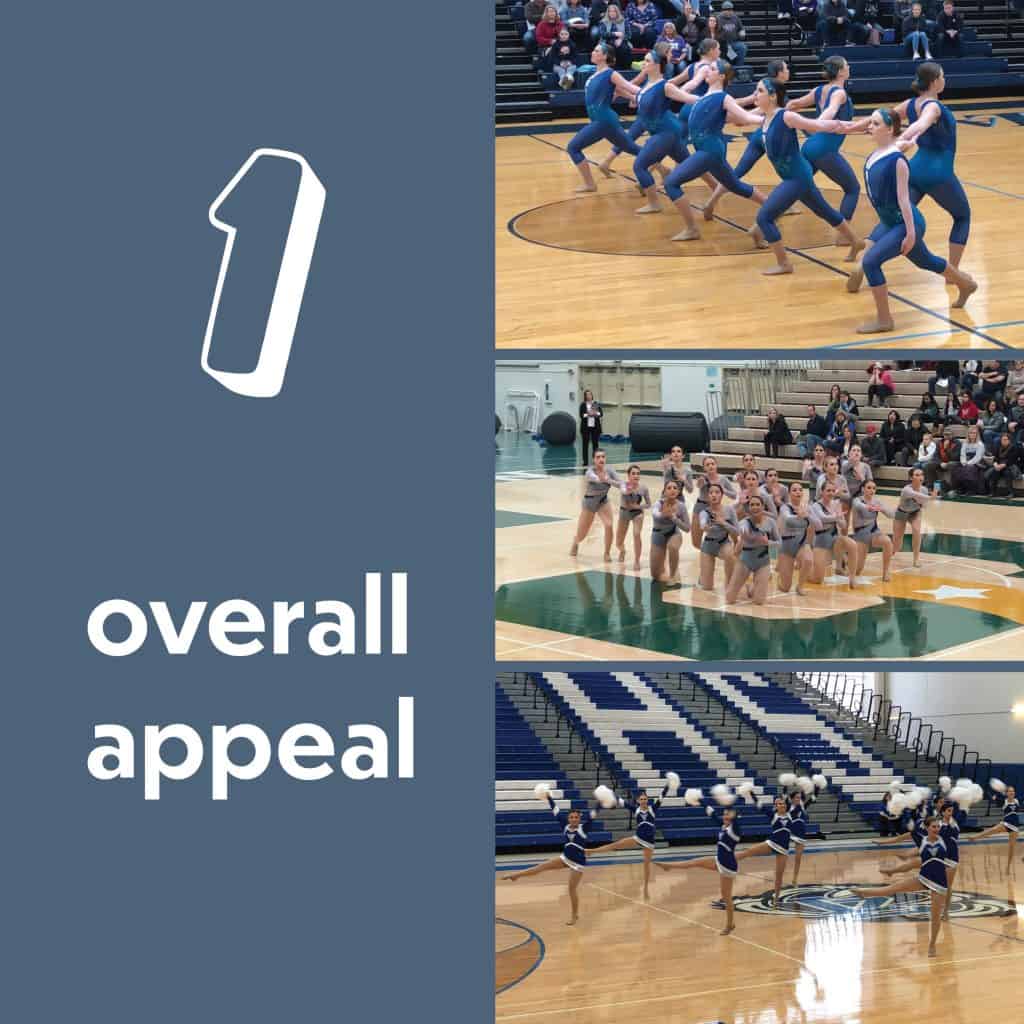
Ok, ok…I started you off with a vague element, but it’s important! As a fan watching a performance, I’m looking for what kind of vibe the team is giving off. Maybe it’s fun energy, or it could be raw intensity. Even in delicate lyrical pieces, the crowd needs to be drawn in. Costumes and music are a huge part of this, and obviously your choreo and faces and execution will keep us hooked. But right off the bat, we fans can get a feeling of whether you’re confident out there, and whether you’re eager to show us what you’ve been working on.
Basically, overall appeal is about quickly answering this question from someone watching in the bleachers: Is this dance something I need and want to watch? Overall appeal is about showing us that what you’re about to perform is compelling. It’s about saying, “Watch us, and you’ll be glad you did.”
12/27/18: ATHLETICISM

A performance is your chance to prove to people what you already know: this is a sport! Most people in the bleachers haven’t been at your practices, haven’t heard the heavy breathing after a full-out run, and haven’t seen how fast you guys empty your water bottles at breaks.
Athleticism is one of those things that always shows up at some point in the dance whether you plan on it or not. It’s conditioning and stamina, of course (it’s pretty astounding what you dancers accomplish in a kick routine, for example, or the level changes we see in hip hop, UDA-style pom, and modern jazz).
Strength reveals itself is plenty of ways. Basic pom technique calls for strong arms for those crisp, sharp movements so that your high-V doesn’t look like a wimpy-U. All those lifts we see in jazz, lyrical, and contemporary show off your strength and also your stamina if it comes towards the end of the routine. Hip hop routines are constant displays of athletic ability from start to finish, from the flashy kips and headsprings and stunts, to the subtle contractions and tutting.
But athleticism is also a part of good dance technique, and a lot of that is about core strength. Whether you’re ripping 10 a la secondes or a humble double pirouette, your core strength will come into play, and we can see that from the bleachers! Pretty leaps and calypsos? It’s about strong rear ends.
Another thing that fans can see, even if they don’t understand it, is how your athleticism feeds into the choreography and the performance. Maybe your dance’s style calls for sharp movements, so that takes athletic ability to initiate the move and also to stop it cleanly. Or, if your dance is about smoothly connecting sequences and combinations, it definitely takes athleticism to make it look like it all flows seamlessly together.
Whether it’s a gym floor or marley, I know that when the music starts, I’m about to watch athletes do their thing. For the folks in the bleachers who don’t quite appreciate that fact, you’ve got about 2 to 3 minutes to make your case!
12/28/18: EMOTIONAL DELIVERY
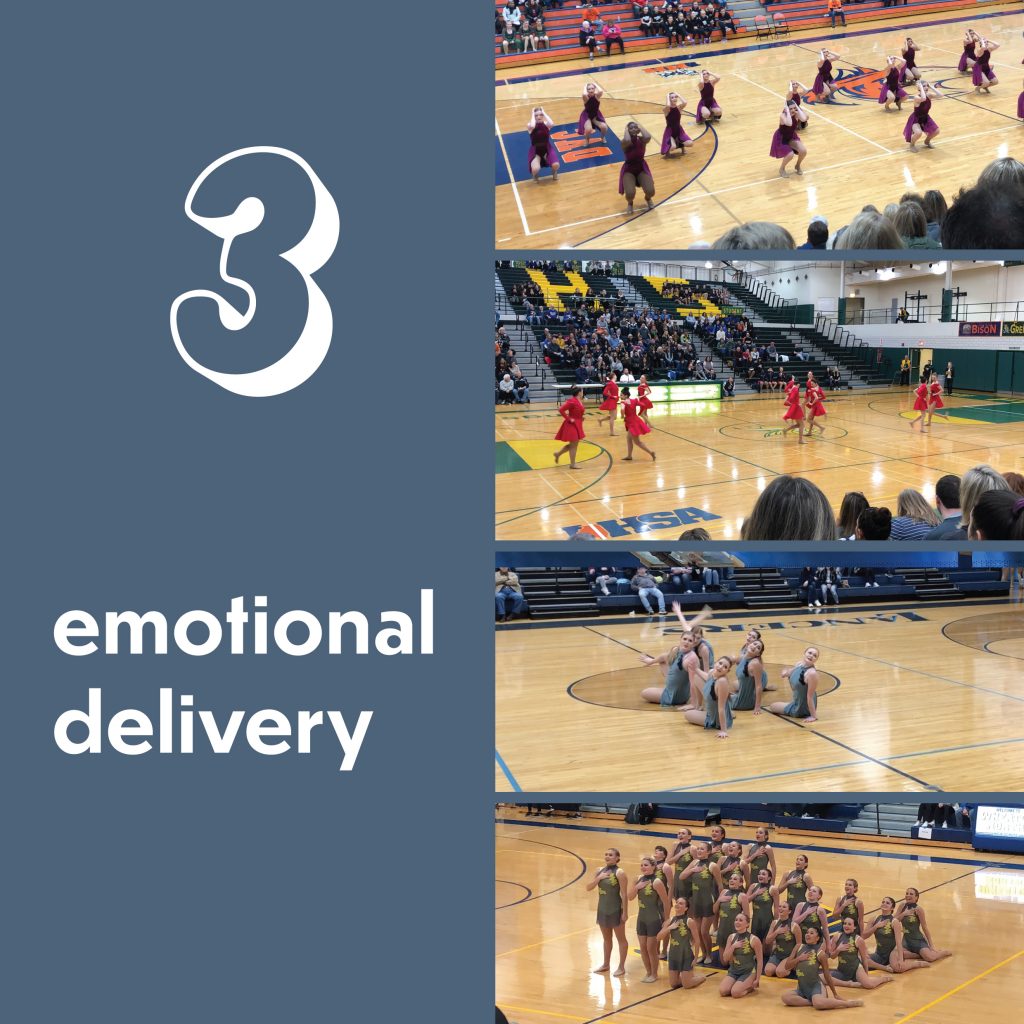
Sometimes we watch dances and we just feel the performance. Your emotional delivery goes way beyond facials! I love seeing that a team is connected with their song, and that they love the work of showing how much they understand the soul of the music and lyrics and the singer’s performance.
Teams that are really good at emotional delivery make me feel like they actually wrote the song. No, not just wrote it–but penned it late at night in their rooms on notebook paper, because the lyrics just keep you up until dawn. It’s a blissful feeling for the audience when we start to believe this, that you’re behind the lyrics, and that you played and recorded every instrument in the music.
OK, that’s a crazy-high standard, right? You don’t have to be at that level to earn emotional delivery points in my world! But show us that you’re aware of how vulnerable you are out there on the floor, channeling a song that maybe you personally haven’t lived, but that you can understand, and that you can make us understand. If you’re willing to be open to that…to embrace the vulnerability…you’ll be totally fine in terms of emotional delivery!
Another way to look at it: you’re there to sell it. Can you get us to buy it? I might not exactly be ready to buy into it if, say, the faces look legit but don’t evolve with the ups and downs of the song. Don’t forget to take advantage of the fact that the audience can pick up on your emotions by your posture and how you hold your center, and obviously what you say with all the angles on your body from head to toe.
Be authentic and legit. Or more accurately, look authentic and legit. It’s totally possible to do that without living the song 24/7. But for those moments when you’re on the floor with an audience and judges in front of you, be in that song’s world, and we’ll be drawn into your world.
Make sure that the first thought in our heads as you walk off the floor is, “I felt that one!”
12/29/18: THE VISUALS
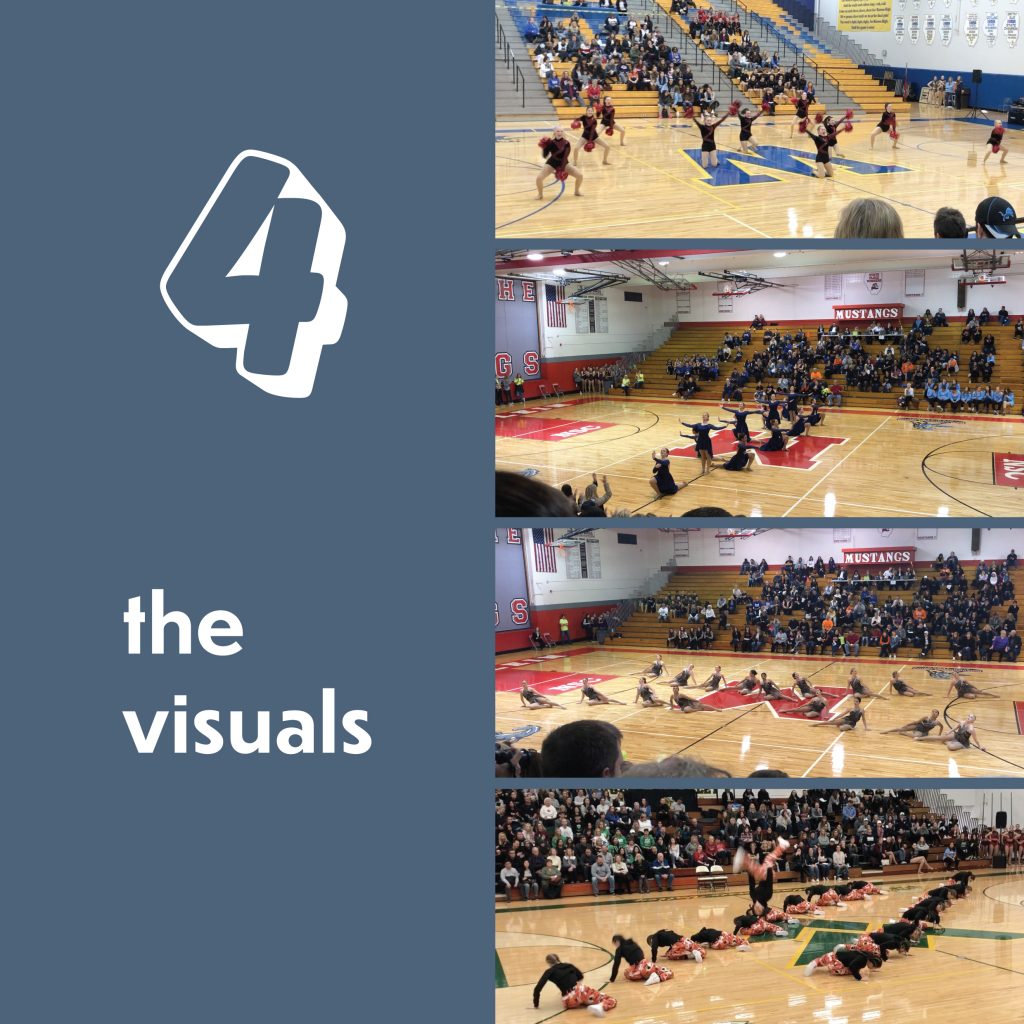
It’s hard to pinpoint exactly what makes something pleasing to the eye, but I think formations are one of the biggest “hooks” of any routine. They’ve got to be clear and easy to pick up on for those of us in the bleachers. Orderly arrangements are like candy to the brain, so hopefully your spacing is good and even! Even the most casual fan can pick up on whether your columns or windows look a little off.
You’ll definitely not want to get stuck in one formation for too long. Transitioning to the next form is something you’ll want to figure out in practice (I’ve noticed that this eats up a lot of time, and it’s always worth it). Here’s where spacing, angles, and alignment can start to waver. You’ve got tools to help you: all those basketball and volleyball lines. On the flip side, fans also use those tools to check your formations (whether we mean to or not).
I personally love the visual impact of certain formations. Xs at various angles, circles, diagonals, and any shape that’s not too boxy or linear are all enjoyable to watch. Diagonals are notoriously tricky to get right, but that’s what makes them so impressive! Weaving lines and countermovement looks super cool, and don’t even get me started on how fun concentric circles look, especially when the inside and outside circles move in opposite directions (clockwise or counterclockwise)!
Costumes definitely make a difference in the visual impact. You don’t necessarily need the craziest sequins or neon colors, but then again, it’s always wise to not look like everyone else, and also to visualize what your outfit might look like against certain gym floors on your comp schedule, or against a black marley floor at state.
For those of you with pom routines (even just for halftime dances), remember that color work, tosses, and trades are for the eyes what cheese fries are to a hungry stomach.
It all starts before the music plays. Even as you’re walking onto the floor, the audience picks up some clues about your dance. It’s the costumes, it’s the size and colors of your poms (if that’s your dance style). Small poms and a uniform? My mind’s already getting out the checklist of things I expect to see in a UDA-style pom routine. Bigger poms and two or more colors? My mind’s gearing up for a creative theme and fun tosses and trades. Dresses with a fringed hem? Well, if you don’t bring the sass, we’re all gonna feel a little empty inside.
Don’t forget–your view is so very different from ours. It’s a big floor, with lots of room left-to-right, front-to-back, and even high and low. Use that space creatively, boldly, and neatly! Help out fans who are sitting way up top, or fans who are a little bit clueless: keep it easy on the eyes.
12/30/18: STAGE PRESENCE
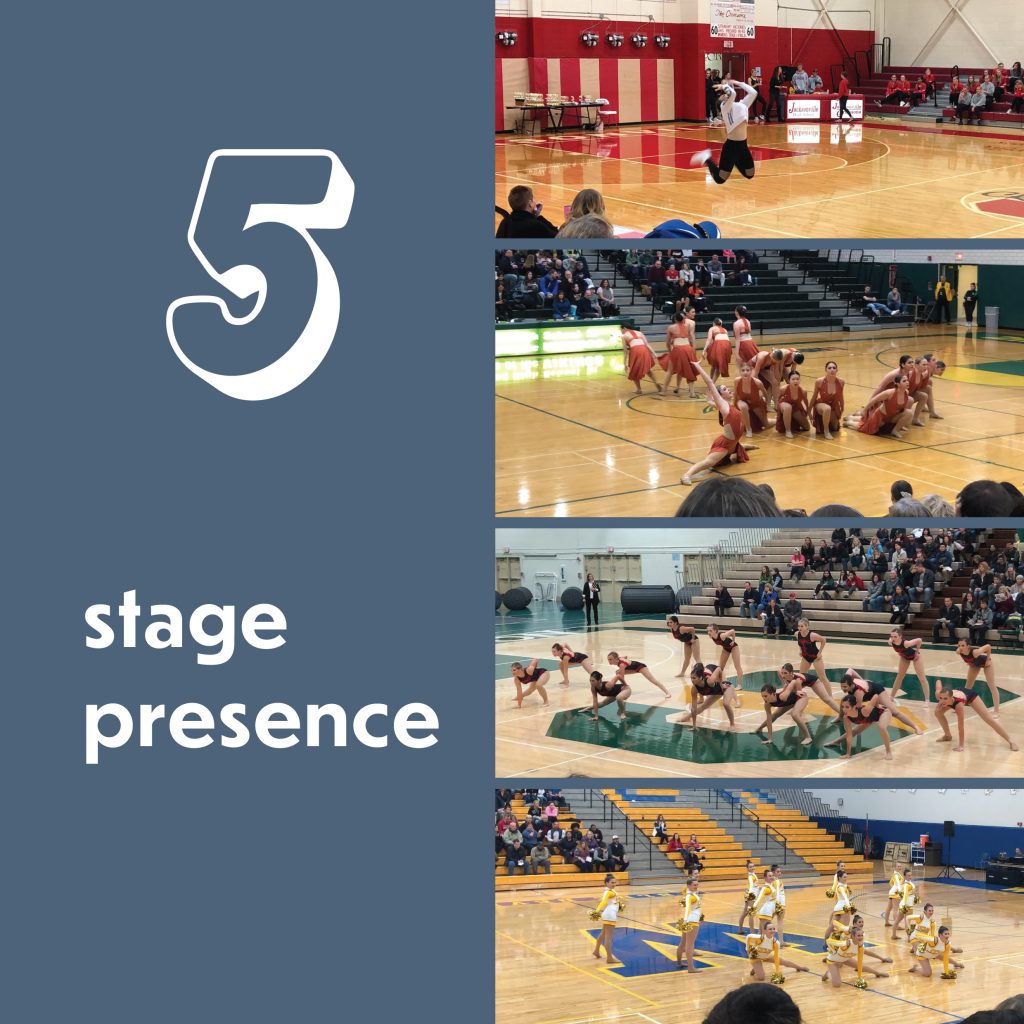
Also known as having command of the floor, this is all about convincing the audience that you’re fully in charge of that space and that moment. It’s confidence in your abilities, your routine, and your teammates. It’s looking like you get that all those hours of preparation have led up to this opportunity to shine!
You can also think of stage presence as showmanship. Being a performer means putting everything aside and making sure you’re fully committed to the dance. It also means faces and postures that get the fans to fully commit to your performance!
Let’s say you’ve got some blah choreo, generic costumes, or sketchy skills. You can still win the stage presence game by exuding confidence. Look like you’re in charge of the floor, even when walking on and off. Look like you’re not going to settle for anything less than the audience’s full attention.
If you’ve got good facials and sharp movements, it only really counts if people in the top row can see that. For some reason human beings overestimate how dramatic our movements are. You’ve heard it a million times in practice: “More! Bigger!” Fully commit to each physical and mental element in your performance.
Stage presence also has to do with poise when things don’t go right, whether it’s a major mistake or a slight imperfection. We’ve all seen the worst case scenarios: the music cuts out, or a dancer gets hurt. Amazingly I almost always see teams overcome it and finish the dance pretty strong. I think these teams pull that off by a combination of poise, faith in each other, and being committed to that one performance, that single chance they have to own the floor and the entire gym’s attention.
Even the smaller hiccups can reveal your stage command skills (and they’re way more common then a music fail). Fall out of a turn? Just clean and stay in character, and fully own the wonderful moment of recovering and cleaning! Dropped pom? Make the decision to pick it up or leave it, but just keep going and don’t lose the facial or start to look hesitant. Stumbled on the aerial or your spotlight skill? Or do you notice you’re off-sync on your turns or headsprings? I’m more interested in your recovery and attitude for the rest of the dance, and not the mistake.
The question to ask yourself when it comes to judging your own showmanship is, “Who’s in charge of this dance?” And when I’m watching, I’m asking myself, “Are they committed to this performance?”
12/31/18: MUSICALITY
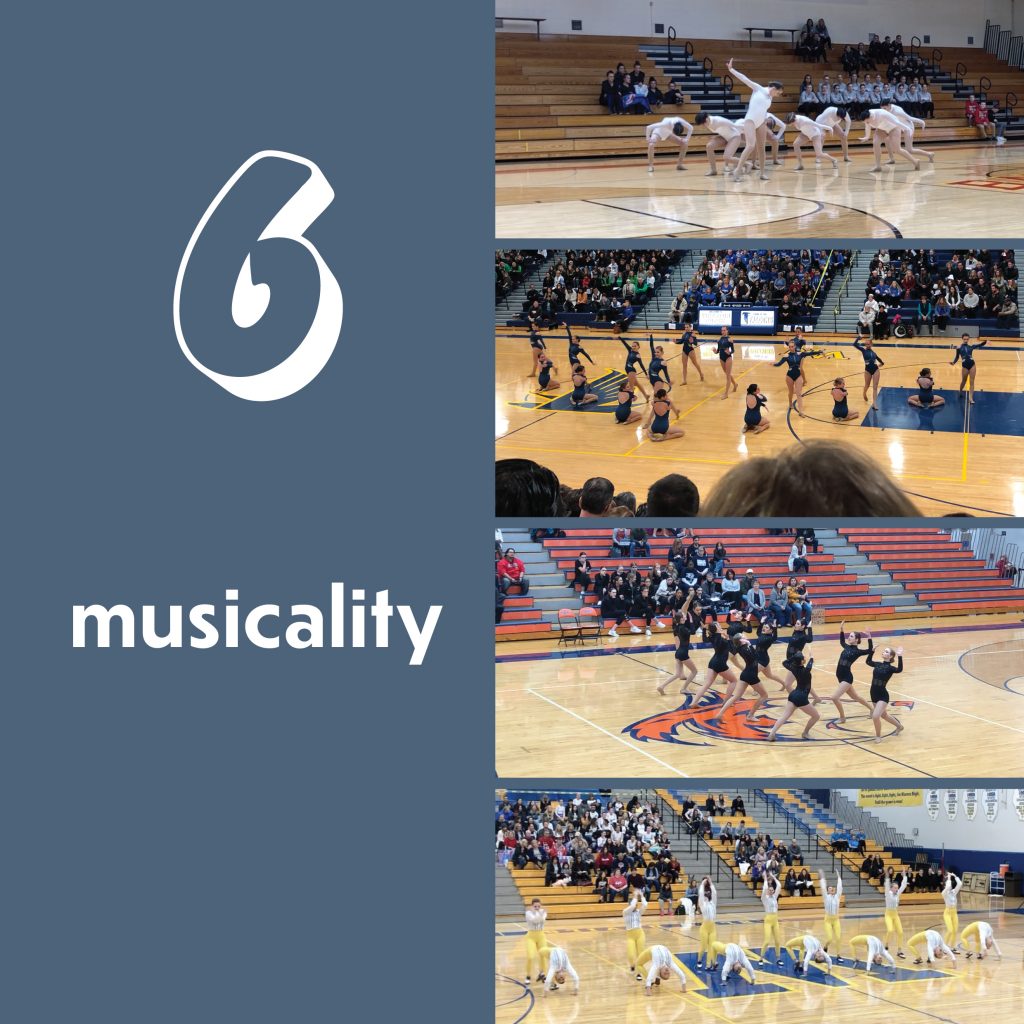
Getting music and dance to work together is my personal area of expertise (look for a more detailed series of posts on musicality during the offseason). Basically what the audience hopes for is that you use every ounce of the music (including the lyric’s and singer’s performance) in your choreography.
OK, it’s true that you realistically can’t use every element of the music, or make sure every little thing the drummer does is reflected on the dance floor. But just make sure to not leave out any important features of the music! The big, spotlight moments in your dance need to match up nicely with the big, spotlight moments of the music. When evaluating musicality, I’m asking myself, “Do the music and the choreography like each other?”
Here’s another way to think of it. Whenever I’m asked to mix songs together (usually for pom and hip hop routines) I have to make sure that the songs all get along and sound like one unified idea. And we can take that a step further: it’s up to the team and choreographer to make sure that the music plus the dance look like a single “whole.”
Zooming into the details, I love it when I’m watching a routine and all the highlights hit on the right beats in the music. You know how a combination has just a couple big moments and the rest of it is mostly preps, expressiveness, and cleaning counts? Music works the same way: in an eight-count of music, there might be 1 or 2 really important chords or notes, or maybe 4 significant drum hits. Or even in a single lyric line, maybe just 1 or 2 words are more impactful than the others. Hopefully your choreo shows this!
Same goes for entire sections of the song or dance. Look at your chorus or any of the verses. I bet one 8-count sounds carries more weight in the music, and as a fan watching, I’m expecting that your biggest skills happen at those moments, while the other 8-counts are slightly more chill.
Speaking of skills, I know that we’re in an era where we feel the need to cram as many skills as possible into a 2 minute routine. Rapid-fire skills can wow us in the audience but it can feel forced. It’s way more organic if the skills and big moments are spread out in a way that works with the natural peaks and valleys in the music. You want to prevent a fan from thinking, “Did they just do that aerial because they could, or was it something the music actually asked for?”
A good test for musicality is to see if your choreography would work with any other song. If you watch a video of your routine with a different song of the same tempo playing in the background, and it works, then you’ve got to step up your musicality.
Yet another way I look at musicality is seeing if the dancers look like they really get the technical music and audio elements of the song. Let’s say your music isn’t countable by fours or eights, but instead by threes, sixes, and twelves. Most of the time, if you’re counting a song wrong, it’ll just look unnatural on the floor.
Here’s another quick example. It’s possible to perform an OK dance if your song has a shuffle tempo (where the numbered counts are longer than the “and” counts) but you decide to dance it to “straight eighths” (where the numbered counts and “and” counts are the same length). On the other hand, it looks fantastic when every movement, especially prep counts, matches up to the shuffle feel of the music.
If that stuff leaves your head spinning, here’s a quick way to think of musicality. Does the routine look like it’s made for that song? Bonus points if it sounds like the song is made for just that one routine. Triple bonus points if the artist ever sends you a message saying, “Your routine is exactly how I pictured my song would be danced!” K, that probably won’t happen, but at least you’ll get a shout out on our 8CA Twitter feed.
1/1/19: DYNAMICS
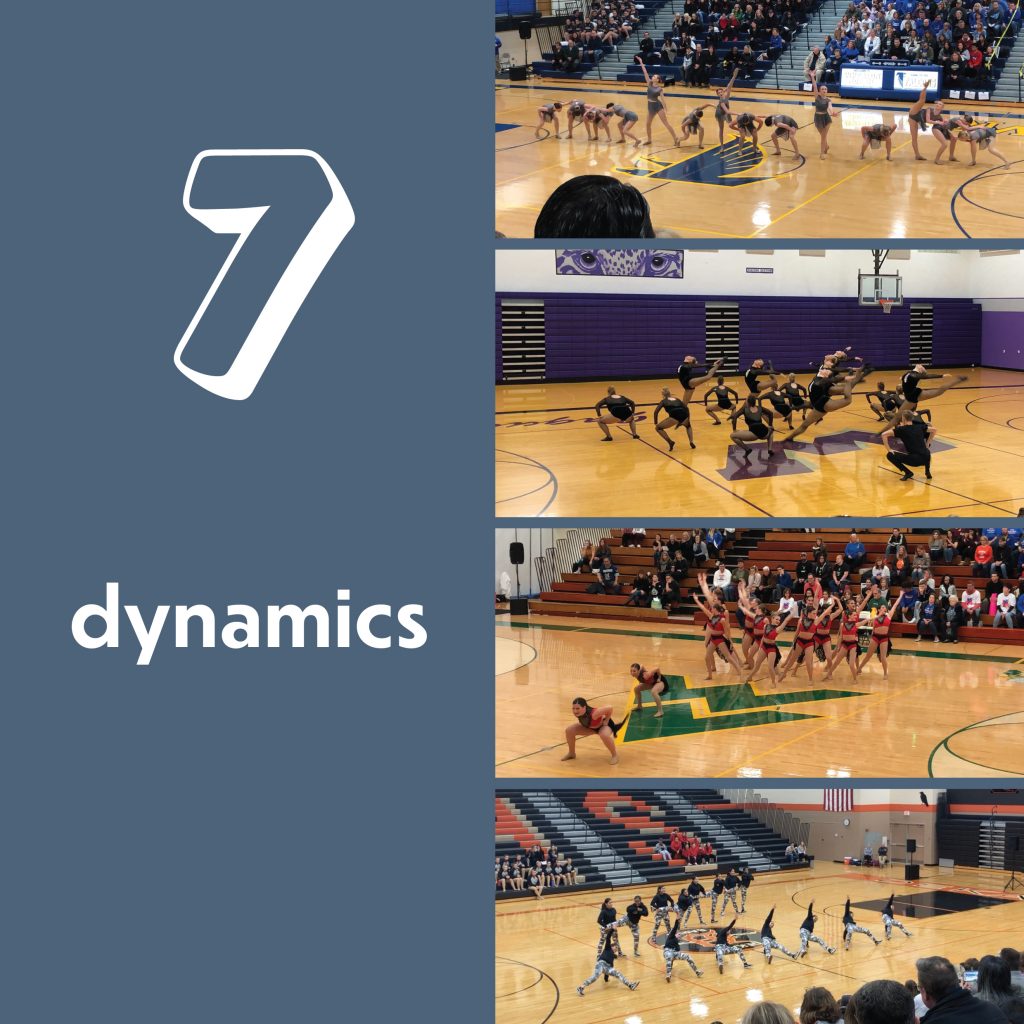
I bet that at least once this holiday season, you had to sit at a family gathering and listen to someone’s story that went nowhere. That would be a lack of dynamics, where there’s no movement up and down as time moves along, no climax, and definitely no satisfying payoff when the end comes.
I like watching routines where there’s more than one level of intensity. One way to do that is to build the routine like a plot line, where there’s an initial hook, and then a buildup to a peak, some more peaks and valleys, building conflict, a climax, and a wrap-up.
That’s a lot of ground to cover in 2 or 3 minutes (like when your teacher assigns 30 pages to read and realistically you’re only going to get to half of it), but there are definitely other ways to build a dynamic routine!
Dynamics is about changing the level, and it really pops when you feature contrasts back-to-back. Formations that expand and contract give the audience a feeling that your dance is a living, breathing thing–something to be watched, instead of just looked at. Movements that shift one way on the floor have a bigger impact if you follow them up with movements in the opposite direction (left-right, front-back, high-low).
Intensity level is a fun dynamic to play with and it tends to draw in the audience. We’ve all loved those hip hop routines where the team hits it fast and hard for a couple 8-counts, and then suddenly changes gears with a slow lean or small torso contractions. Hip hop routines usually involve a mix of songs, so it’s pretty easy to build-in some dramatic moments where the energy deliberately drops with a clever break in the music.
Dramatic shifts also work great in other styles. York’s 3A championship routine last season is an amazing example of having the first 3/4 of the dance be sharp, cutting dark jazz, and then ending it with an ultra-dramatic, almost lyrical section with a huge change in the music.
If you’re still wondering about dynamics, check out kick routines (especially by Minnesota high school teams). They usually feed the audience what we crave, with formations that range from stacked lines to that long “company front” that extends across the whole floor from left to right.
We often think of dynamic as becoming bigger and louder, but it’s equally effective to pair this with going smaller and softer. One pom coach this season asked me for advice on how to make a key voiceover in her music stick out more (the judges weren’t hearing the line, and so they weren’t connecting it with a choreo trick happening at that moment). Instead of making that 8-count of the song louder, I told her to have her music person drop out every music element in that moment except the voiceover. That makes the voiceover easy to hear, sure, but it also screams out to the audience, “Pay attention to this big moment in my routine!”
Routines are way more enjoyable if they kind of unfold, and you can achieve that in tons of ways. Obviously as dancers, you’re out their moving…but is the routine moving, too? If it is, your dynamics are thriving.
1/2/19: EXECUTION
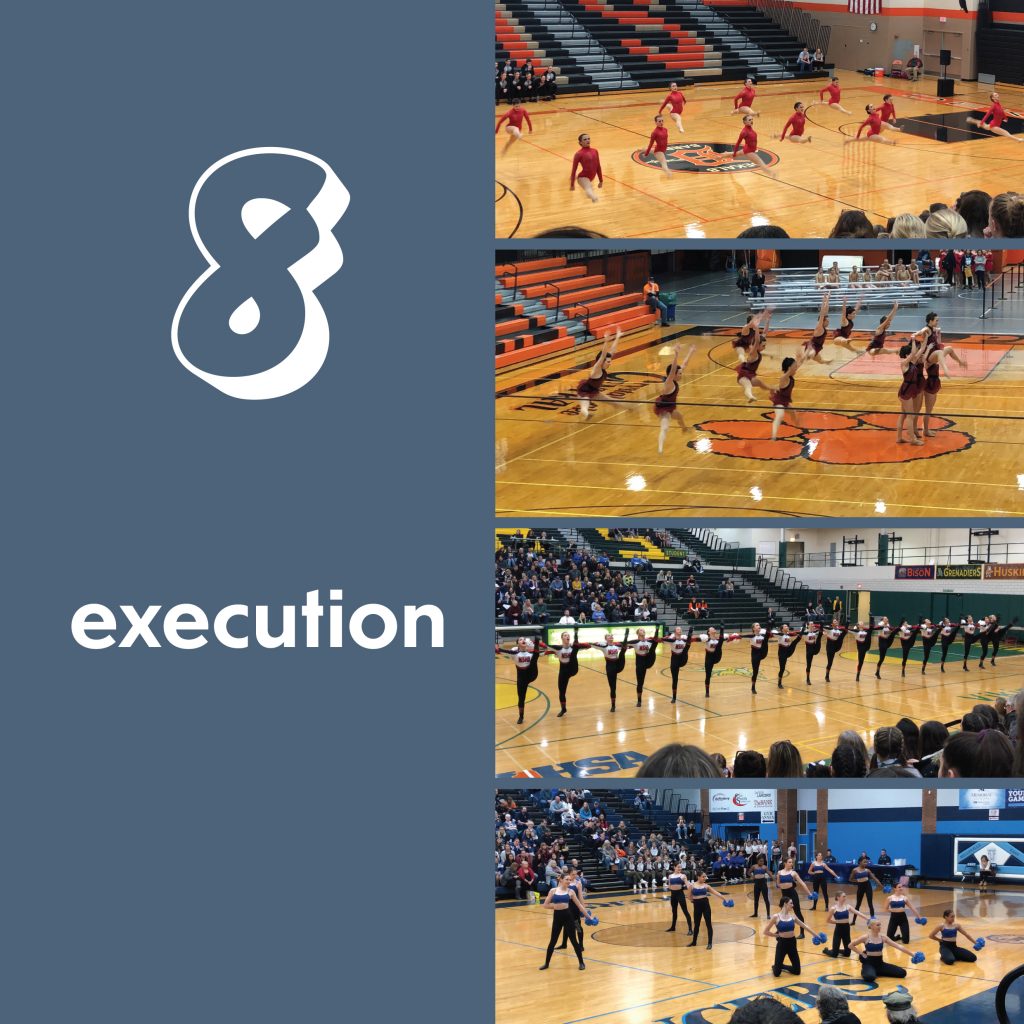
You’ve mastered your routine in practice, but the competition floor is your chance to channel those dozens of hours of hard work into a single performance in front of fans and judges. Knowing the dance and polishing it in practice is a totally different thing from executing it when it counts!
I bet you’re more than familiar with the adjectives we use in the execution department. Clean, crisp, sharp.
It’s a lot to ask for, but the ultimate ideal standard is if all team members look like each other. Coming from different studios can make this challenging, but ultimately your team is a team and you have to figure out how you want to look, and commit to that.
On the non-IHSA rubrics that your coaches grew up with, synchronization was also known as “ensemble work.” Fans without formal dance training can pick up on whether they’re watching a a group of individual dancers who happen to be dancing the same routine, or a unified team performing a single idea. Here’s where you’ll have to put the studio world aside and think “competitive team dance.” That means working as an ensemble!
Turns are the classic case of synchro issues. The harsh truth is that out-of-sync turns just stick out like a zit when you’re on a first date. Out in the bleachers, the judges of course pick up on rotation issues that casual fans miss or don’t really care about. But one of the first things that any audience member detects is any spotting that’s not synchronized, because we’re so focused on your faces. It’s not just when the head turns but how it turns (is it snappy or flowy?) that needs to match. Once we pick up on the fact that someone’s spots are off, we can’t help but want to look lower and figure out if arms and legs are also late / early. Don’t let us start down that rabbit hole!
A close second in the list of synchro issues that stick out to fans are leaps. I feel like turns are more forgiving (I mean, on the 8th a la seconde it’s pretty understandable if something starts to become “off”). But with leaps? You just get that one moment, and either they’re together or they’re not.
Matching isn’t just about technique. I love watching routines where it’s clear that the team pays attention to the details. Arms are easy to notice, whether it’s pom, hip hop, or jazz. Level changes (or anything squat-like) need to match. Wrists, head facings, and even how spread apart your fingers are…it’s all important stuff that shows your commitment to the details. Pom routines have their own special requirements, like making sure that tosses (especially to yourself) are all the same height. Hip hop dances have a big burden when it comes to synchronizing kips and headsprings, which is why the audience goes wild when teams pull them off perfectly.
I’ll leave you with this nugget. Whenever I get to watch teams watch other teams’ videos, one of the fastest critiques that comes out of their mouths is, “It’s clean.” Whether it’s grandma or a trained studio dancer, people notice sharpness and synchronization really easily. And here’s the thing: synchro is easily fixable!
1/3/19: CHOREOGRAPHY

It wasn’t too long ago, say, 2010-16, that every jazz routine came in one of two varieties: sassy (a few of them) or intimidating (a lot of them). These days the competitive dance scene in Illinois is a little more creative, but still rooted in that hard-hitting, modern jazz style.
Freshness in choreography has never been so important. After a decade of dances that start to all look the same, you’ll definitely capture the audience’s attention with something a little different. Walk onto the floor with a certain kind of costume, and fill the gym’s sound system with a certain kind of song, and you’ll soon have a lot of folks in the bleachers thinking, “Ohhhh…this is one of those routines. Didn’t we see this 10 times already today?”
Not that we’re gonna automatically yawn if you’re inspired by choreo we’re all familiar with. Fans are comfortable with what’s familiar and traditional, so you’ll totally need that aspect in your dance. Execute it well, sharpen it up, inject some twists and freshness here and there, and you’ll be good. But take a chance on bold, unexpected ideas, oddball song choices, or interesting costumes, and you’ll stand out and make a lasting impression.
Whether you go the safe route or the fresh route, one thing that always hooks the audience is layered choreography. The downside is that it’s challenging to make the groups look evenly spaced and orderly, and who knows which group a judge is going to lock in on. But it immediately gives the dance a sense of motion and liveliness.
If layered isn’t your thing, an easy way to spice things up is with a spotlight moment, whether it’s a lift or some other feature. On the other hand, after watching the dance a couple times, I start to look away from the feature and instead focus on the rest of the team. Are they hiding a weakness in choreo or skills? Or is the rest of the team doing something that’s cool to watch also? Whatever the case, I can promise you that more than a few people in the crowd are watching away from the spotlight part of the floor. Hopefully those dancers are doing their thing cleanly and sharply!
One more argument in favor of originality. I come from a music production background where I have to routinely come up with original music ideas quickly. One of the wisest pieces of advice comes from a Nashville recording session “ace” guitarist who I really look up to. His advice for musicians recording a solo in a song: “Don’t play the obvious.” I think this works really well when applied to choreography. I mean, if a dad in the bleachers feels like this combo is going to end in a spinning disc, maybe it’s time to shake up your choreo habits.
Gyms get hot over a 6 or 7 hour competition day, and usually there aren’t outside doors to prop open. So be that breath of fresh air, and keep the audience on its toes with choreography that stands out yet feels comfortably familiar. Quite the challenge, but it’s worth it!
1/4/19: SKILLS & TECHNIQUE
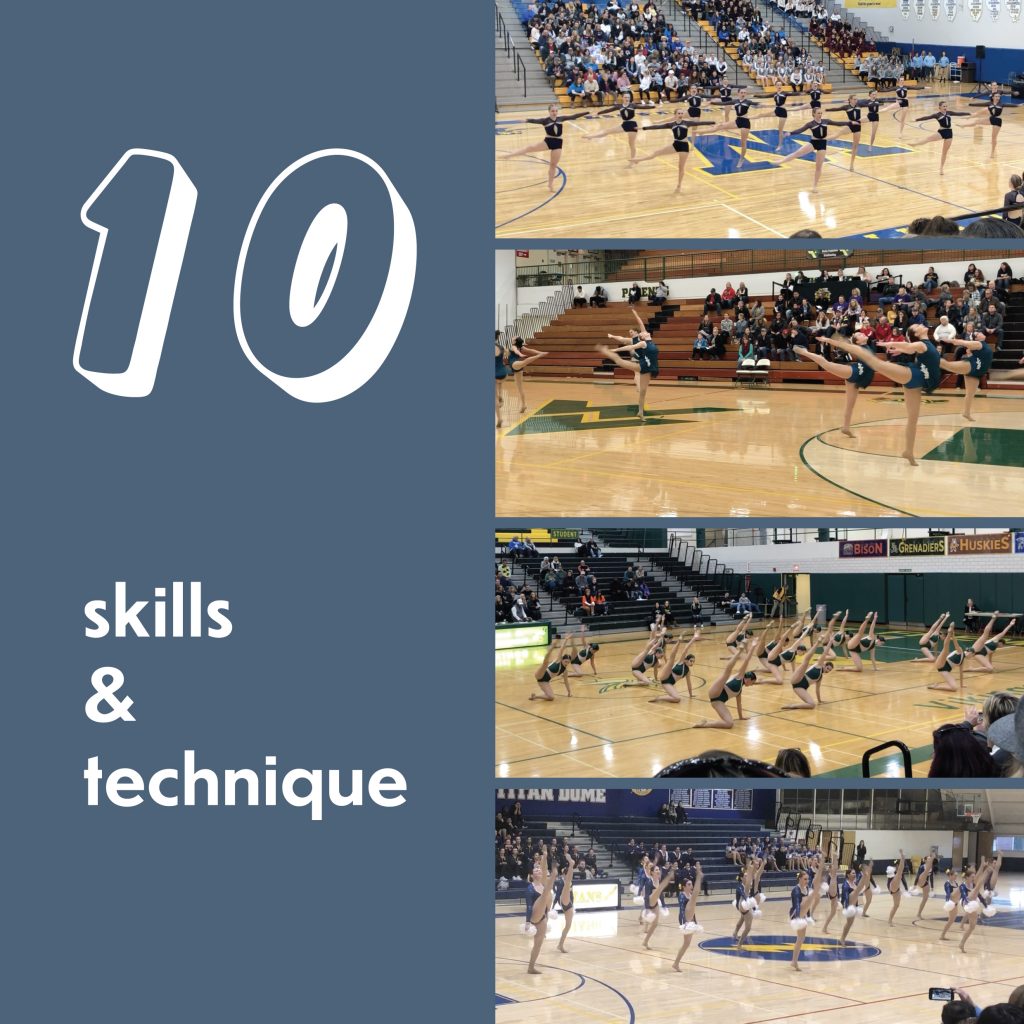
Ok, put the official rubric aside for a minute. As a fan, I can still appreciate routines that don’t have advanced skills. It’s so cool watching a really clean and solid double done by dancers who may not have a full armament of ballet and jazz skills.
Speaking of turns, it wasn’t all that long ago when we were wowed by triples and classic fouéttes. In the past decade, though, we save the oohs and ahhs for quads. The a la secondes started taking over, and once we got used to those, we started wanting changing spot turns. Aerials and lifts used to stand out, and now they’re just part of a checklist of what we’re used to seeing.
I don’t even want to guess at what the next big thing will be…because I’d rather see more teams do these more solidly. When was the last time you saw a changing spot turn sequence look super sharp?
Judges will nitpick technique issues that go under the radar for the rest of us in the bleachers. Still, more people in the audience than you think can pick up on a lot of little things. Unpointed toes? Low-ish relevés? Turns that run of of steam toward the end? Lazy back leg on leaps?
Teams with one problem on that list tend to have all the problems on this list (and I’m sure you all can add to the list). So much of it depends on core and rear-end strength, flexibility, and stamina. It’s not hard to figure out who’s using glutes on their arabesque and who’s just lifting like I would.
The good news is that it’s all fixable. There’s no doubt that we all develop crushes on routines that shine with top-tier skills and technique. But there’s room to give high fives to teams at the mid and lower technical levels, too. The key question here is whether they’re maximizing their talents and are working toward improving, week to week and comp to comp. I’m proud to say that I’ve seen plenty of that this season and every season…teams stepping up, no matter how little studio training they have on the roster.
We all love seeing talented dancers execute switch leaps, spinning discs, physically improbable penchés and elegant coupé turns. Personally, I also love the basics, done cleanly: simple fan kicks, tilts, chaînés while traveling. Put enough of both the “advanced” and “standard” stuff into a dance (woven together in combos, with dynamic formations, all with musicality) and you’ve got a tasty dessert at a nice restaurant.
But I’m also up for some ice cream from the store. You can still hook an audience with lower and medium skills and technical ability. Do what you can, cleanly, and confidently. It’ll show, and the crowd will give you credit. And next week, or next summer, reach for more with the help of technique workshops and expand what it means to do what you can!
I think a team pretty much shows who they are in the first :20 of a dance. At that point, I’ve got a decent estimation of their skill level. And from then on I can look at the routine through that lens. I just want to see a team maxing out, being the best at who they are. I’ll still go wild for the insane combos done beautifully by all the you-know-whos in our dance world. Just know that I’ll always nod in approval of that super clean double!
Happy 2019! Clean your routine and sharpen your technique with our certified 8CA staffers! They’ve got tons of coaching, choreo, and teaching experience and have brought teams to that downstate marley. Email us at choreography@8countaudio.com to set up a session.
